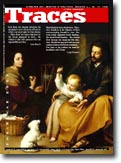
Traces N.10, November 2002
Prayer, the Primary Gesture of Those Who Are Aware of a Precise Alternative, Which Starts Out in Their Own HeartsSomeone wrote that violence is the midwife of history. The midwife is the factor that makes it grow, the motor, the lever setting concrete historic changes to motion. Only violence, they say, changes the state of things. Hosts of men, under various ideologies, have been educated to this way of thinking. Thus, violence has been rampant and is rampant in the world. Every bloody event, it seems, can be answered only by another bloody event. And the atrocities increase in their savagery and evil daring, as we have seen in recent times, after New York, Bali, and Moscow, and in so many wars and persecutions. It is almost never the violence of an angry crowd or of tramps. It is systematic, precise, and directed by educated, lucid minds. Every time one makes an effort to reason about one of these acts, immediately other acts of violence are called up, as a sort of sinister justification, which were perpetrated by the victims (or rather–and it is not the same thing!–by the governments of the victims) against the criminals. This is a spiral that seems to cause every possibility to vanish into nothingness.
The world is teeming with hate. Not to sense this state of things, this paralyzing gas that creeps its way into relationships even with our closest neighbors, means living in a fool’s paradise on another planet. The law of violence of homo homini lupus (“man is a wolf to other men”) is not a legacy of some obscure past. It is a possibility that is always present. And it is, we repeat, not only a given of “nature”–Christians acknowledge the evil that lies in man because of sin–but also the fruit of an education that, in various ways and with countless nuances, holds as central this way of dealing with and possessing reality.
The prayer that the Pope insistently asks us to raise to heaven is not a useless good deed for candid souls. It is the primary gesture of those who are aware of a precise alternative, which starts out in our own hearts and our own reason.
What is the source of hope in history? What establishes the possibility to construct, as much as possible, more just conditions of life? What should we consider when we desire a change for the better?
In many houses, under many arcades, at many intersections, images of Our Lady can still be seen. They are the signs of a faith that was popular and widespread. They were placed there because, as the French poet and playwright Paul Claudel wrote, in order to pray, man does not need to be in a special place or mood or to be standing in front of a masterpiece like Michelangelo’s Last Judgment. For a man who knows the drama of his own heart, it is enough to look even at this modest little image of Our Lady, an apparently insignificant sign, a small sign of the grand mystery of the Incarnation, in order to touch what is the living fountain of hope and constructiveness, in the secret wars of personal life and in those open for all to see. Mary’s “Yes,” her hands that bring Christ and continue to bring Him into the life and companionship of Christians, have touched and set on its journey a people that is different in history. The great pilgrimage of our Fraternity to Loreto was a special event. This is because not violence, but only familiarity with the good face of Mystery makes some pieces of history, some places of history, new, until everything is revealed in its Destiny. And it makes us more constructive, more tenacious, and more patient in times of trial.